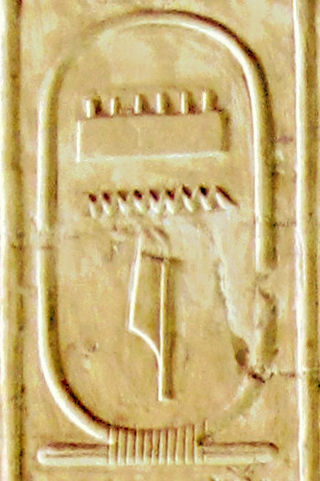This article needs additional citations for verification .(December 2009) |
Amu was the nineteenth and last pharaoh of the Hyksos Sixteenth Dynasty of Egypt. [1] preceded by Yoam.
This article needs additional citations for verification .(December 2009) |
Amu was the nineteenth and last pharaoh of the Hyksos Sixteenth Dynasty of Egypt. [1] preceded by Yoam.

Pharaoh is the vernacular term often used for the monarchs of ancient Egypt, who ruled from the First Dynasty until the annexation of Egypt by the Roman Republic in 30 BCE. However, regardless of gender, "king" was the term used most frequently by the ancient Egyptians for their monarchs through the middle of the Eighteenth Dynasty during the New Kingdom. The earliest confirmed instances of "pharaoh" used contemporaneously for a ruler were a letter to Akhenaten or an inscription possibly referring to Thutmose III.

The Ptolemaic dynasty, also known as the Lagid dynasty, was a Macedonian Greek royal house which ruled the Ptolemaic Kingdom in Ancient Egypt during the Hellenistic period. Reigning for 275 years, the Ptolemaic was the longest and last dynasty of ancient Egypt from 305 BC until its incorporation into the Roman Republic in 30 BC.

Menes was a pharaoh of the Early Dynastic Period of ancient Egypt, credited by classical tradition with having united Upper and Lower Egypt, and as the founder of the First Dynasty.
The history of ancient Egypt spans the period from the early prehistoric settlements of the northern Nile valley to the Roman conquest of Egypt in 30 BC. The pharaonic period, the period in which Egypt was ruled by a pharaoh, is dated from the 32nd century BC, when Upper and Lower Egypt were unified, until the country fell under Macedonian rule in 332 BC.

The New Kingdom, also referred to as the Egyptian Empire, was the ancient Egyptian nation between the 16th century BC and the 11th century BC. This period of ancient Egyptian history covers the Eighteenth, Nineteenth, and Twentieth Dynasties. Through radiocarbon dating, the establishment of the New Kingdom has been placed between 1570 BC and 1544 BC. The New Kingdom followed the Second Intermediate Period and was succeeded by the Third Intermediate Period. It was the most prosperous time for the Egyptian people and marked the peak of Egypt's power.
The Twenty-eighth Dynasty of Egypt is usually classified as the third dynasty of the Ancient Egyptian Late Period. The 28th Dynasty lasted from 404 BC to 398 BC and it includes only one Pharaoh, Amyrtaeus (Amenirdis), also known as Psamtik V or Psammetichus V. Amyrtaeus was probably the grandson of the Amyrtaeus of Sais, who carried on a rebellion in 465–463 BC with the Egyptian chief, Inarus, against the satrap Achaemenes of Achaemenid Egypt.

The Egyptian pyramids are ancient masonry structures located in Egypt. Sources cite at least 118 identified "Egyptian" pyramids. Approximately 80 pyramids were built within the Kingdom of Kush, now located in the modern country of Sudan. Of those located in modern Egypt, most were built as tombs for the country's pharaohs and their consorts during the Old and Middle Kingdom periods.

Hor-Aha is considered the second pharaoh of the First Dynasty of Egypt by some Egyptologists, while others consider him the first one and corresponding to Menes. He lived around the 31st century BC and is thought to have had a long reign.

The Twenty-second Dynasty of Egypt is also known as the Bubastite Dynasty, since the pharaohs originally ruled from the city of Bubastis. It was founded by Shoshenq I.

The Late Period of ancient Egypt refers to the last flowering of native Egyptian rulers after the Third Intermediate Period in the 26th Saite Dynasty founded by Psamtik I, but includes the time of Achaemenid Persian rule over Egypt after the conquest by Cambyses II in 525 BC as well. The Late Period existed from 664 BC until 332 BC, following a period of foreign rule by the Nubian 25th Dynasty and beginning with a short period of Neo-Assyrian suzerainty, with Psamtik I initially ruling as their vassal. The period ended with the conquests of the Persian Empire by Alexander the Great and establishment of the Ptolemaic dynasty by his general Ptolemy I Soter, one of the Hellenistic diadochi from Macedon in northern Greece. With the Macedonian Greek conquest in the latter half of the 4th century BC, the age of Hellenistic Egypt began.

The pschent was the double crown worn by rulers in ancient Egypt. The ancient Egyptians generally referred to it as sekhemty (sḫm.ty), the Two Powerful Ones. It combined the White Hedjet Crown of Upper Egypt and the Red Deshret Crown of Lower Egypt.

The Seventeenth Dynasty of Egypt was a dynasty of pharaohs that ruled in Upper Egypt during the late Second Intermediate Period, approximately from 1580 to 1550 BC. Its mainly Theban rulers are contemporary with the Hyksos of the Fifteenth Dynasty and succeed the Sixteenth Dynasty, which was also based in Thebes.

The Thirteenth Dynasty of ancient Egypt was a series of rulers from approximately 1803 BC until approximately 1649 BC, i.e. for 154 years. It is often classified as the final dynasty of the Middle Kingdom, but some historians instead group it in the Second Intermediate Period.
The royal titulary or royal protocol is the standard naming convention taken by the pharaohs of ancient Egypt. It symbolised worldly power and holy might, also acting as a sort of mission statement for the duration of a monarch's reign.
The Twenty-first, Twenty-second, and Twenty-third Dynasties ruled Egypt from the 10th century through the 8th century BC. The family tree of the Twenty-first dynasty was heavily interconnected with the family of the High Priests of Amun at Thebes. The Twenty-second dynasty and Twenty-third dynasty were also related by marriage to the family of the High Priests.

The Twenty-seventh Dynasty of Egypt, also known as the First Egyptian Satrapy, was a province (Satrapy) of the Achaemenid Persian Empire between 525 BC and 404 BC. It was founded by Cambyses II, the King of Persia, after the Battle of Pelusium and the Achaemenid conquest of Egypt, and his subsequent crowning as Pharaoh of Egypt. It was disestablished upon the rebellion and crowning of Amyrtaeus as Pharaoh. A second period of Achaemenid rule in Egypt occurred under the Thirty-first Dynasty of Egypt.

The Eighteenth Dynasty of Egypt is classified as the first dynasty of the New Kingdom of Egypt, the era in which ancient Egypt achieved the peak of its power. The Eighteenth Dynasty spanned the period from 1550/1549 to 1292 BC. This dynasty is also known as the Thutmoside Dynasty) for the four pharaohs named Thutmose.

The Twentieth Dynasty of Egypt is the third and last dynasty of the Ancient Egyptian New Kingdom period, lasting from 1189 BC to 1077 BC. The 19th and 20th Dynasties together constitute an era known as the Ramesside period. This dynasty is generally considered to mark the beginning of the decline of Ancient Egypt at the transition from the Late Bronze to Iron Age. During the period of the Twentieth Dynasty, Ancient Egypt faced the crisis of invasions by Sea Peoples. The dynasty successfully defended Egypt, while sustaining heavy damage.

The Twenty-fifth Dynasty of Egypt, also known as the Nubian Dynasty, the Kushite Empire, the Black Pharaohs, or the Napatans, after their capital Napata, was the last dynasty of the Third Intermediate Period of Egypt that occurred after the Nubian invasion.